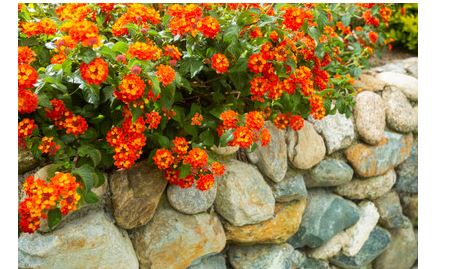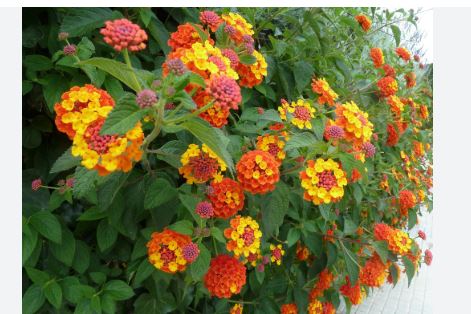
Lantana plants are vibrant, flowering shrubs or perennials known for their colorful, clustered blooms in shades like orange, yellow, pink, red, and white, often with multi-toned flowers. Native to tropical regions of the Americas and Africa, they belong to the Verbenaceae family, primarily Lantana camara or hybrids with Lantana montevidensis. Prized for their ornamental appeal, they attract butterflies and hummingbirds, making them popular in gardens worldwide.
These plants thrive in full sun and well-drained, slightly acidic soil, tolerating heat, drought, and poor soil conditions. They grow as perennials in USDA zones 8–11, often used as annuals in colder climates, and are suited for containers, borders, or groundcovers. Their adaptability makes them ideal for low-maintenance landscapes.
Lantanas bloom prolifically from late spring to frost, with some varieties flowering year-round in frost-free zones. Their flowers change color as they age, adding dynamic visual interest. While most are grown for aesthetics, some produce toxic berries, requiring caution in gardens with pets or children.
Their growth habits range from compact (10–12 inches) to sprawling (up to 6 feet), with some sterile hybrids preventing invasive spread. They require minimal care, needing occasional pruning to maintain shape and encourage blooming. Their deer-resistant foliage and pollinator-friendly blooms enhance garden ecosystems.
Challenges include potential invasiveness in warm climates, where they can spread aggressively, and toxicity concerns. Regular deadheading and monitoring prevent unwanted growth. Their versatility, vibrant colors, and ecological benefits make lantanas a favorite for sunny gardens and urban landscaping.

Orange Lantana Varieties
Bandana Orange
Bandana Orange is a compact Lantana camara cultivar (12–26 inches tall and wide) with vibrant, solid orange flower clusters that bloom from late spring to frost. Originating from tropical Americas, it’s a hybrid developed for garden use, thriving in full sun and well-drained, slightly acidic soil. It’s drought- and heat-tolerant, ideal for containers, borders, or mass plantings in USDA zones 9–11 (annual in colder zones). Its bright orange blooms attract butterflies and hummingbirds, and its deer-resistant foliage suits low-maintenance gardens.
Bandito Orange Sunrise
Bandito Orange Sunrise is a dwarf Lantana camara hybrid (12–14 inches tall and wide) with orange flowers that transition from yellow centers to deep orange edges. Developed in the United States for container gardening, it thrives in full sun, well-drained soil, and hot climates, making it suitable for hanging baskets or small garden beds in zones 9–11. Its mounding habit and prolific blooms attract pollinators, and its drought tolerance ensures easy care in sunny, dry landscapes.
Radiation
Radiation, also known as Red Sage, is a tall Lantana camara cultivar (4–6 feet tall and wide) with dual-toned red-orange and yellow flower clusters. Native to tropical Americas, it’s a vigorous, upright shrub that blooms year-round in frost-free zones (8–11) and from spring to fall elsewhere. It prefers full sun and well-drained soil, tolerating drought and heat, making it ideal for large containers or as a focal point in gardens. Its bold orange blooms attract butterflies but may produce toxic berries.
Miss Huff
Miss Huff is a hardy Lantana camara cultivar (5–6 feet tall, 8–10 feet wide) with vibrant orange, yellow, and coral flower clusters. Originating from tropical Americas and bred in the United States, it’s one of the most cold-hardy lantanas (zone 7b), blooming from summer to fall. It thrives in full sun, well-drained soil, and is drought-tolerant, suiting shrub borders or butterfly gardens. Its sterile flowers ensure continuous blooming without berry production, ideal for non-invasive landscaping.
Patriot Cowboy
Patriot Cowboy is a compact Lantana camara hybrid (12 inches tall and wide) with flowers that start bright yellow, shift to orange, and mature to bright orange. Developed in the United States, it’s perfect for small gardens, containers, or edging in zones 9–11, thriving in full sun and well-drained soil. Its heat and drought tolerance make it low-maintenance, while its vibrant orange blooms attract pollinators, adding color to patios or walkways.
Bandolista Mango
Bandolista Mango is a Lantana camara hybrid (12–14 inches tall, 10–12 inches wide) with a mix of red, yellow, and orange flowers, emphasizing bright orange hues. Bred for container culture in the United States, it has a mounding, slightly trailing habit, ideal for hanging baskets or borders in zones 9–11. It thrives in full sun, well-drained soil, and is heat- and salt-tolerant, attracting butterflies and hummingbirds. Its sterile blooms ensure continuous flowering without invasive spread.
Texas Sunset
Texas Sunset is a Lantana camara hybrid (12–24 inches tall, 18–24 inches wide) with arching branches bearing golden yellow, orange, and red flower clusters, with orange dominating as blooms mature. Originating in the United States, it thrives in full sun, well-drained soil, and hot climates (zones 8–11), suiting containers, rock gardens, or slopes. Its drought and heat tolerance, along with pollinator-friendly orange blooms, make it a vibrant, low-maintenance choice.
New Red
New Red is a Lantana camara cultivar (2–3 feet tall and wide) with vivid red-orange flowers mixed with yellow, offering a strong orange display. Native to tropical Americas and hybridized for gardens, it blooms from spring to frost in zones 9–11, thriving in full sun and well-drained soil. Its upright habit suits mixed borders or containers, and its drought tolerance and pollinator appeal make it ideal for sunny, low-care landscapes.
Grandpa’s Pumpkin Patch
Grandpa’s Pumpkin Patch is a Lantana camara hybrid (1–2 feet tall, 3–4 feet wide) with brilliant pumpkin-orange flower clusters and yellow centers. Developed in the United States, it blooms from late spring to frost in zones 8–11, thriving in full sun and well-drained soil. Its spreading habit suits groundcovers or containers, and its deer-resistant, drought-tolerant nature attracts butterflies, making it a vibrant addition to butterfly gardens.
Little Lucky Orange
Little Lucky Orange is a dwarf Lantana camara cultivar (10–12 inches tall and wide) with fragrant orange and yellow flower clusters that bloom early, about three weeks before other lantanas. Bred in the United States, it’s ideal for containers, window boxes, or small garden beds in zones 9–11, preferring full sun and well-drained soil. Its compact size, heat tolerance, and pollinator-friendly blooms make it a low-maintenance choice for vibrant color.